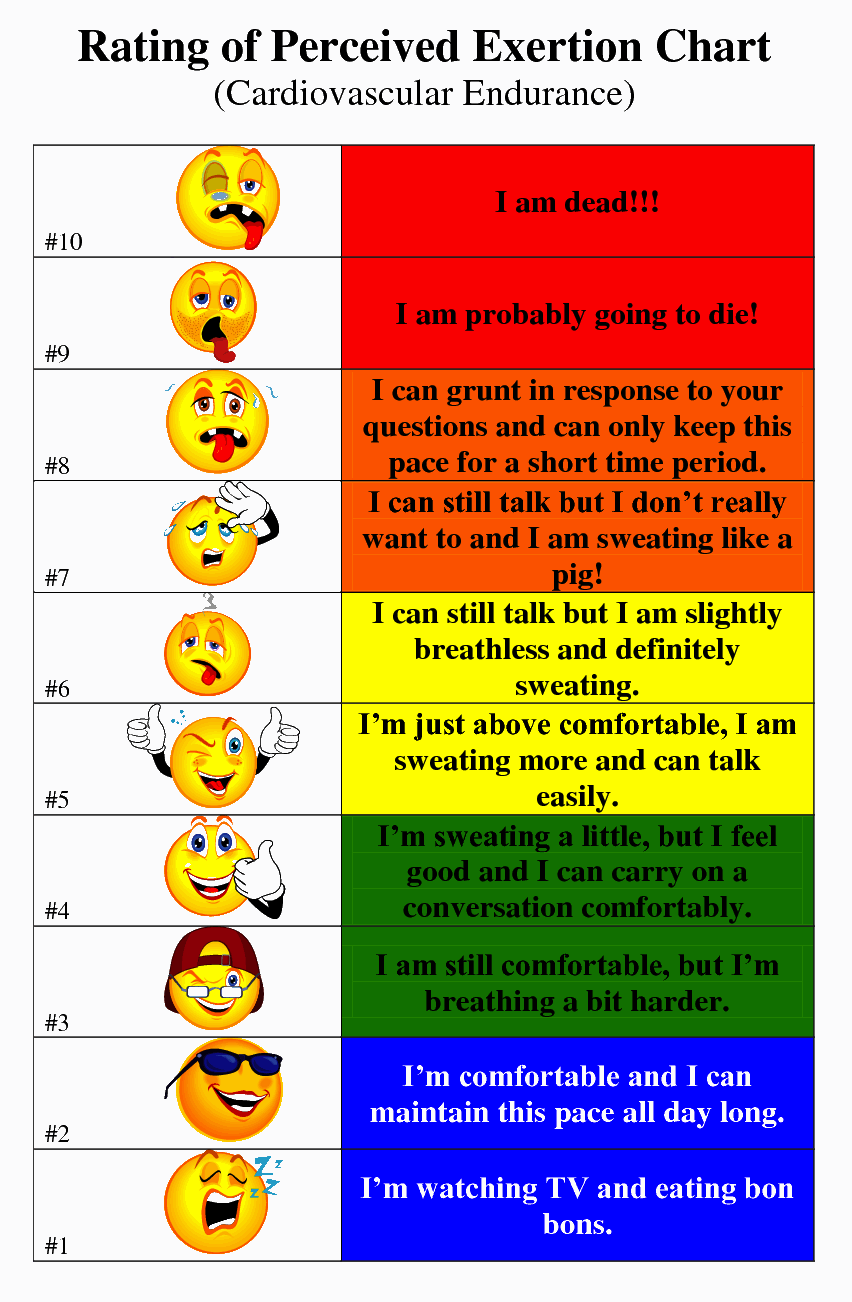Rate Of Perceived Exertion Chart . Typically during a bruce protocol, heart rate and rating of perceived exertion are taken every minute and blood pressure is taken at the end of each stage (every three minutes). Further, it’ll ask you three questions around intensity and completion.
What Is Rpe And Rpe Scale? from irunmaps.com
Use this target heart rate calculator chart to determine your heart rate in four exercise intensity zones. For example, 0 (nothing at all) would be how you feel when. The rpe scale is used to measure the intensity of your exercise.
What Is Rpe And Rpe Scale?
The scale uses numbers from 6 to 20. The lowest rating is “no feeling of. It is based on the physical sensations a person experiences during physical activity, including increased heart rate, increased respiration or breathing rate, increased sweating, and muscle fatigue. And given that you will use the same method each time you.
Source: www.facebook.com
Low intensity, moderate intensity, vigorous intensity, and the aerobic zone. Use this target heart rate calculator chart to determine your heart rate in four exercise intensity zones. Both of these are far from perfect, but they can give you a tss estimation which is close. This method relies on your judgment of how hard you think you're exercising based on.
Source: irunmaps.com
It is based on observations like higher heart rate, heavier and faster breathing, increased sweating, and muscles feeling tired. Stage minutes % grade mph min/mile km/h. Although this is a subjective measure, your exertion rating based on a 6 to 20 rating scale, may provide a fairly. The borg scale of perceived exertion measures your exercise intensity by rating how.
Source: maximizepotentialtx.com
We’ll tell you more about this scale, how it corresponds to. The borg cr10 scale was the first scale to provide exertion ratings from 1 to 10, and it was. It can be difficult to track a workout’s intensity level. Rpe, or rate of perceived exertion, is a way to measure the intensity of your workouts. For example, 0 (nothing.
Source: www.arrowptseattle.com
It is based on the physical sensations a person experiences during physical activity, including increased heart rate, increased respiration or breathing rate, increased sweating, and muscle fatigue. It is based on observations like higher heart rate, heavier and faster breathing, increased sweating, and muscles feeling tired. This method relies on your judgment of how hard you think you're exercising based.
Source: simplifaster.com
A rating of perceived exertion (rpe). Below is a chart detailing a sample week of cardio workouts for a person who exercises six days a week. If you don't have an exercise stress test, your care provider may recommend measuring your exercise intensity using a perceived exertion scale, such as the borg rating of perceived exertion scale. For example, 0.
Source: marathonhandbook.com
The lowest rating is “no feeling of. A rating of perceived exertion (rpe). It is based on observations like higher heart rate, heavier and faster breathing, increased sweating, and muscles feeling tired. We’ll tell you more about this scale, how it corresponds to. This is simply an example of how to incorporate different types of cardio workouts into a typical.
Source:
We’ll tell you more about this scale, how it corresponds to. If you don't have an exercise stress test, your care provider may recommend measuring your exercise intensity using a perceived exertion scale, such as the borg rating of perceived exertion scale. The borg scale of perceived exertion measures your exercise intensity by rating how you feel. Low intensity, moderate.
Source: www.stormfitnessacademy.co.uk
Perceived exertion is how hard you feel like your body is working. Below is a perceived exertion chart that can help individuals identify what level of intensity they are exercising at. Both of these are far from perfect, but they can give you a tss estimation which is close. Afterward (or, by just tapping the activity), you’ll see the heart.
Source: hookedonrunning.com.au
I usually recommend interpreting peloton’s levels as rpe (rate of perceived exertion) levels. Below is a perceived exertion chart that can help individuals identify what level of intensity they are exercising at. Stage minutes % grade mph min/mile km/h. The borg cr10 scale was the first scale to provide exertion ratings from 1 to 10, and it was. Typically during.
Source: www.arrowptseattle.com
Both of these are far from perfect, but they can give you a tss estimation which is close. A rating of perceived exertion (rpe). If you don't have an exercise stress test, your care provider may recommend measuring your exercise intensity using a perceived exertion scale, such as the borg rating of perceived exertion scale. The borg scale of perceived.
Source: bitbetter.coach
The borg cr10 scale was the first scale to provide exertion ratings from 1 to 10, and it was. The lowest rating is “no feeling of. The numbers below relate to phrases used to rate how easy or difficult you find an activity. Use this target heart rate calculator chart to determine your heart rate in four exercise intensity zones..
Source: thefittutor.com
And given that you will use the same method each time you. Typically during a bruce protocol, heart rate and rating of perceived exertion are taken every minute and blood pressure is taken at the end of each stage (every three minutes). This is simply an example of how to incorporate different types of cardio workouts into a typical week..
Source: www.amazon.com
A rating of perceived exertion (rpe). If you don't have an exercise stress test, your care provider may recommend measuring your exercise intensity using a perceived exertion scale, such as the borg rating of perceived exertion scale. It is based on the physical sensations a person experiences during physical activity, including increased heart rate, increased respiration or breathing rate, increased.
Source: www.gophersport.com
The scale uses numbers from 6 to 20. The numbers below relate to phrases used to rate how easy or difficult you find an activity. Stage minutes % grade mph min/mile km/h. I usually recommend interpreting peloton’s levels as rpe (rate of perceived exertion) levels. To monitor your intensity, make sure you keep track of your target heart rate or.
Source: www.freeprintablemedicalforms.com
Remember that greater health benefits are. To monitor your intensity, make sure you keep track of your target heart rate or use a perceived exertion chart. The tss data point from the workout is then inserted into the performance management chart you see. It can be difficult to track a workout’s intensity level. Afterward (or, by just tapping the activity),.
Source: productivefitness.ca
If you don't have an exercise stress test, your care provider may recommend measuring your exercise intensity using a perceived exertion scale, such as the borg rating of perceived exertion scale. Low intensity, moderate intensity, vigorous intensity, and the aerobic zone. Stage minutes % grade mph min/mile km/h. A rating of perceived exertion (rpe). This makes it so users on.
Source: marathonhandbook.com
The lowest rating is “no feeling of. It can be difficult to track a workout’s intensity level. Stage minutes % grade mph min/mile km/h. This is simply an example of how to incorporate different types of cardio workouts into a typical week. The scale uses numbers from 6 to 20.
Source: fitnesstogether.com
Use this target heart rate calculator chart to determine your heart rate in four exercise intensity zones. I usually recommend interpreting peloton’s levels as rpe (rate of perceived exertion) levels. Although this is a subjective measure, your exertion rating based on a 6 to 20 rating scale, may provide a fairly. Typically during a bruce protocol, heart rate and rating.
Source: app.wizer.me
A rating of perceived exertion (rpe). Below is a chart detailing a sample week of cardio workouts for a person who exercises six days a week. Low intensity, moderate intensity, vigorous intensity, and the aerobic zone. We’ll tell you more about this scale, how it corresponds to. It can be difficult to track a workout’s intensity level.
Source: www.youtube.com
The scale uses numbers from 6 to 20. Use this target heart rate calculator chart to determine your heart rate in four exercise intensity zones. We’ll tell you more about this scale, how it corresponds to. Further, it’ll ask you three questions around intensity and completion. Below is a chart detailing a sample week of cardio workouts for a person.

